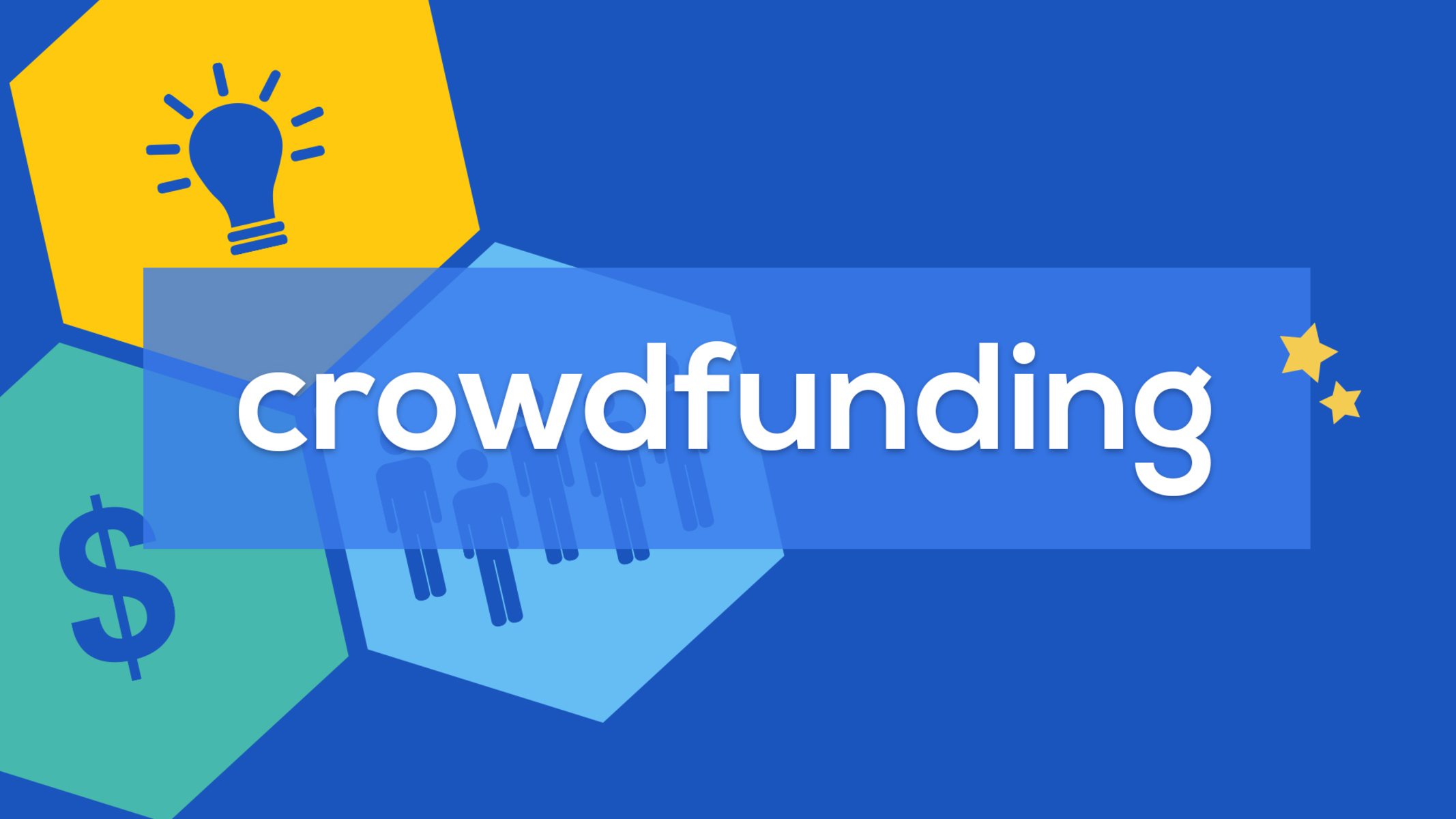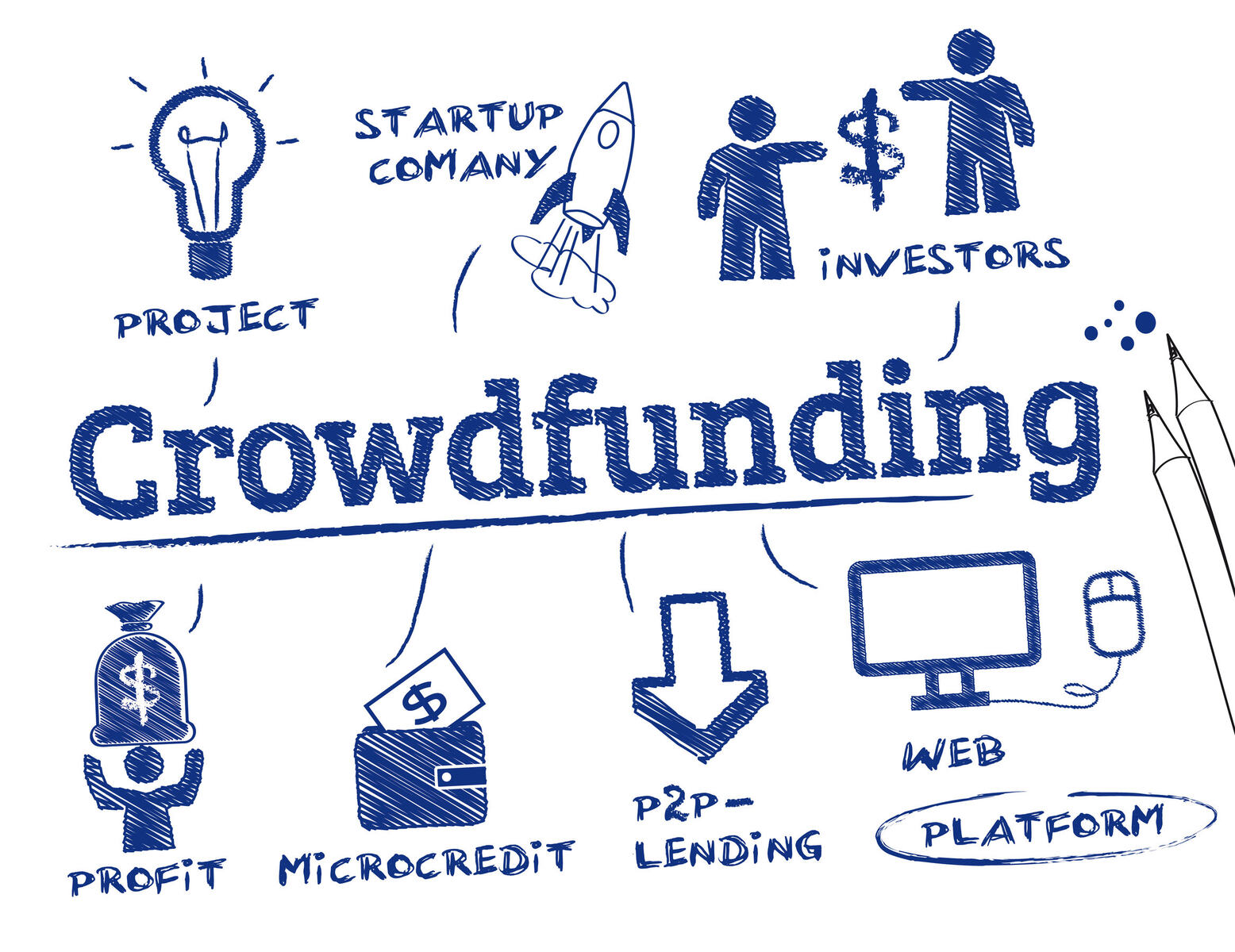Introduction
Welcome to the world of crowdfunding, a game-changing concept that has transformed the way entrepreneurs and creatives raise funds for their projects. Crowdfunding has emerged as a viable alternative to traditional methods of funding, such as bank loans and venture capital, allowing individuals to harness the power of the crowd to finance their dreams.
So, what exactly is crowdfunding? In simple terms, it is a mechanism that enables individuals or organizations to raise money from a large number of people, typically through an online platform. This collective effort not only helps entrepreneurs secure the necessary funds for their projects but also allows supporters to contribute to causes they believe in and reap the rewards of their investment.
The concept of crowdfunding is not a recent phenomenon. As far back as the 17th century, people would come together to fund public projects, such as the construction of bridges and monuments. However, with the advent of technology and the rise of the internet, crowdfunding has taken on a whole new dimension, democratizing the fundraising process and giving birth to a myriad of innovative ideas.
One of the defining aspects of crowdfunding is the diverse range of projects that can benefit from it. Whether it’s a tech startup developing a groundbreaking app, an independent filmmaker producing a passion project, or a nonprofit organization looking to fund a charitable initiative, crowdfunding opens doors for anyone with a compelling vision and a persuasive story.
Moreover, crowdfunding offers a unique opportunity for entrepreneurs and creatives to validate their ideas and gauge market demand. By putting their project out in the public domain and receiving funding from interested individuals, they can test the viability of their concept and gather valuable feedback.
However, as with any fundraising method, crowdfunding also comes with its own set of challenges and risks. It requires careful planning, strategic marketing, and an engaging campaign to capture the attention and support of potential backers. In this article, we will delve deeper into the different types of crowdfunding, the benefits it offers to entrepreneurs, the risks involved, and tips for running a successful campaign.
Definition of Crowdfunding
Crowdfunding is a form of fundraising that involves pooling small amounts of money from a large number of people to finance a project, business venture, or cause. It harnesses the power of the internet and social media to connect creators and entrepreneurs with potential backers who are interested in supporting their ideas.
At its core, crowdfunding is a collaborative effort that allows individuals to become part of something bigger than themselves. It breaks down traditional barriers of entry by providing a platform for creators to showcase their projects and appeal directly to the crowd for financial support.
There are various types of crowdfunding models, each with its own unique characteristics. The most common models include:
- Reward-based Crowdfunding: In this model, backers contribute funds in exchange for non-financial rewards, such as early access to a product, exclusive merchandise, or a mention in the credits of a film.
- Equity-based Crowdfunding: This model involves raising funds by offering backers equity or shares in the company. It allows individuals to become shareholders and potentially profit from the success of the venture.
- Donation-based Crowdfunding: Here, individuals contribute funds to support a cause or project without expecting anything in return. This model is often used for charitable initiatives, social campaigns, or community-based projects.
- Debt-based Crowdfunding: Also known as peer-to-peer lending, this model involves raising funds through loans that are repaid with interest over a specified period. It provides an alternative for borrowers who may not qualify for traditional bank loans.
Regardless of the model, crowdfunding relies on effective storytelling and communication to engage potential backers and convince them to contribute. Creators must showcase their project’s unique value proposition, outline their goals and objectives, and offer compelling incentives to attract support.
With the increasing popularity of crowdfunding, numerous online platforms have emerged to facilitate these fundraising campaigns. These platforms provide a user-friendly interface, payment processing services, and built-in social sharing features to maximize a project’s exposure and reach a wider audience.
It’s essential to note that crowdfunding is not a guarantee of success. While it offers a significant opportunity for entrepreneurs and creators to secure funding, it requires careful planning, marketing efforts, and a compelling campaign to stand out in the crowded marketplace of ideas.
Brief History of Crowdfunding
Crowdfunding may seem like a relatively new concept, but its roots can be traced back through history. The concept of pooling resources from a large group of people to fund projects has been around for centuries, albeit in different forms and on a smaller scale.
One of the earliest examples of crowdfunding can be seen in the late 17th century, when the construction of important public structures like bridges and churches relied on collective funding from communities. These projects were often financed through subscriptions or voluntary contributions from local residents who saw the value in investing in shared infrastructure.
Fast forward to the late 20th century, and crowdfunding began to take shape in a more recognizable form. In the 1990s, bands and musicians started to leverage the internet to fund their albums and tours. They would offer exclusive access to unreleased tracks, limited edition merchandise, or private concerts as rewards for fans who contributed to their campaigns.
The true catalyst for the modern crowdfunding revolution, however, came with the rise of social media and the launch of dedicated crowdfunding platforms. In 2003, ArtistShare became one of the first notable crowdfunding platforms, allowing artists to raise funds directly from their fans. The platform gained recognition when jazz musician Maria Schneider funded her Grammy Award-winning album through fan contributions.
Then, in 2008, Kickstarter was launched, marking a significant turning point in the crowdfunding landscape. KickStarter introduced the concept of reward-based crowdfunding, enabling creative projects to seek funding from a global audience. It quickly gained popularity, revolutionizing the way entrepreneurs, artists, and innovators pursued funding for their ideas.
Indiegogo followed suit in 2007 with a similar model, offering creators the opportunity to raise funds for projects ranging from films to technology startups. These platforms provided a way for individuals to bypass traditional funding sources and tap into the power of the crowd to bring their ideas to life.
In 2012, Jumpstart Our Business Startups (JOBS) Act was signed into law in the United States, marking a significant milestone for equity-based crowdfunding. The JOBS Act allowed non-accredited investors to participate in crowdfunding campaigns and receive equity in return. This regulatory change opened up new opportunities for entrepreneurs to secure investment and for individuals to become shareholders in early-stage companies.
Since then, crowdfunding has continued to grow and evolve, with countless success stories and breakthrough projects. Today, crowdfunding has become a diverse and global phenomenon, with platforms catering to various industries, causes, and types of projects.
While the history of crowdfunding may be relatively short, its impact has been profound. It has democratized the funding landscape, giving people from all walks of life the opportunity to turn their dreams into reality with the support of the crowd.
The Different Types of Crowdfunding
Crowdfunding encompasses various models, each with its own characteristics and benefits. Understanding the different types of crowdfunding can help entrepreneurs and creators choose the most suitable approach for their projects. Here are the four main types of crowdfunding:
- Reward-based Crowdfunding: This is the most common form of crowdfunding, where creators offer non-financial rewards to individuals who contribute funds to their project. These rewards can range from early access to the product, exclusive merchandise, personalized experiences, or recognition in the project’s credits. Reward-based crowdfunding is often used by artists, inventors, and product developers looking to bring their creations to market.
- Equity-based Crowdfunding: In this model, backers receive shares or equity in a company in exchange for their financial contribution. Equity crowdfunding provides an opportunity for individuals to invest in early-stage startups and potentially benefit from their future success. It allows entrepreneurs to raise significant capital and attract experienced investors who believe in their vision for growth and profitability.
- Donation-based Crowdfunding: As the name suggests, this type of crowdfunding involves soliciting donations from individuals who support a particular cause, charity, or community project. There are no financial returns or rewards involved, except the satisfaction of contributing to a noble cause. Donation-based crowdfunding is commonly used for humanitarian aid, medical expenses, education initiatives, and community development projects.
- Debt-based Crowdfunding: Also known as peer-to-peer lending or crowdlending, debt-based crowdfunding allows individuals or businesses to borrow funds from a crowd of lenders. Unlike traditional loans from banks, crowdlending platforms connect borrowers with individual lenders who fund the loan in smaller increments. Borrowers pay back the loan over time with interest. Debt-based crowdfunding provides an alternative lending option for individuals or businesses who may not have access to traditional sources of financing.
It’s important for entrepreneurs and creators to evaluate their specific needs, goals, and target audience when selecting the type of crowdfunding that best aligns with their project. Each type of crowdfunding has its own benefits and considerations, such as the level of control given to backers, legal and regulatory requirements, and the potential for financial returns.
It’s also worth noting that hybrid models of crowdfunding have emerged, combining elements from different types to suit specific project requirements. For example, some platforms offer a blend of reward-based and equity-based crowdfunding, allowing backers to receive both non-financial rewards and equity shares in exchange for their contributions.
By understanding the different crowdfunding models and their nuances, entrepreneurs and creators can make informed decisions that align with their project’s vision, funding needs, and target audience. Regardless of the type chosen, a well-planned crowdfunding campaign can provide a valuable platform for showcasing ideas, connecting with supporters, and turning dreams into reality.
Benefits of Crowdfunding for Entrepreneurs
Crowdfunding offers numerous benefits to entrepreneurs, providing them with a unique opportunity to bring their ideas to life and achieve their business goals. Here are some key advantages of crowdfunding:
- Access to Capital: One of the primary benefits of crowdfunding is access to capital without relying solely on traditional funding channels. Entrepreneurs can bypass the lengthy and often challenging process of seeking investment from banks or venture capitalists. Instead, they can tap into a vast network of potential backers who are interested in supporting innovative ideas and have the means to contribute.
- Market Validation: When launching a new product or business, market validation is crucial. Crowdfunding provides a way to gauge interest and demand for the offering by attracting real customers who are willing to invest their money. Positive responses and a successful crowdfunding campaign serve as evidence that there is a market for the product, giving entrepreneurs more confidence as they move forward.
- Building a supportive community: Crowdfunding creates an engaged community of backers who believe in the project’s potential. These supporters not only provide financial contributions but also act as brand advocates, spreading the word about the product or business to their networks. The community formed through crowdfunding can become a loyal customer base and an invaluable source of feedback and suggestions.
- Marketing and Publicity: Running a crowdfunding campaign requires entrepreneurs to promote their projects and tell compelling stories. This process generates media attention and increases public awareness of the venture. Even if the crowdfunding campaign does not reach its funding goal, the marketing efforts can help entrepreneurs attract the attention of potential investors, partners, or customers for future endeavors.
- Control and Independence: Unlike traditional funding methods where entrepreneurs may need to give up equity or control in their ventures, crowdfunding allows them to maintain full ownership and decision-making power. This enables entrepreneurs to pursue their vision without compromising their creative or strategic direction.
- Customer Engagement: Crowdfunding provides a unique opportunity for entrepreneurs to engage directly with their target audience. By involving backers in the journey, entrepreneurs can foster a strong sense of connection, loyalty, and support. Backers become invested in the success of the project, offering valuable insights, feedback, and referrals.
- Educational Experience: Going through the crowdfunding process is a valuable learning experience for entrepreneurs. It requires them to refine their pitch, develop marketing and communication skills, and think strategically about their business. The feedback received from backers can also help entrepreneurs identify areas for improvement and fine-tune their offerings for future success.
Overall, crowdfunding offers a range of benefits for entrepreneurs, from securing needed capital to building a community of engaged supporters. It is a powerful tool that can bring their ideas to life, validate market demand, and propel them on the path to success.
Risks and Challenges of Crowdfunding
While crowdfunding offers numerous benefits, it is crucial for entrepreneurs to be aware of the risks and challenges associated with this funding method. Understanding and addressing these potential pitfalls can help entrepreneurs navigate the crowdfunding landscape more effectively. Here are some key risks and challenges of crowdfunding:
- Failure to Reach Funding Goal: Crowdfunding campaigns operate on an all-or-nothing basis, meaning that entrepreneurs must meet or exceed their predetermined funding goal to access the funds. If the goal is not met within the specified timeframe, all the funds may be returned to the backers, and the entrepreneur receives nothing. Setting a realistic funding target and implementing a robust marketing strategy are essential to maximize the chances of success.
- Competition and Saturation: Crowdfunding has become increasingly popular, leading to a highly competitive environment on crowdfunding platforms. With thousands of campaigns vying for attention, entrepreneurs must find unique ways to stand out from the crowd. A well-executed marketing plan, a compelling story, and differentiation in the product or service offered can help overcome this challenge.
- Time and Resource Intensive: Running a successful crowdfunding campaign requires significant time, effort, and resources. Entrepreneurs must prepare marketing materials, create a compelling campaign page, engage with backers, and manage logistics such as production, fulfillment, and customer service. Underestimating the time and resources required can lead to a poorly executed campaign and potentially negative experiences for backers.
- Managing Expectations: Crowdfunding backers can be highly engaged and invested in the success of the project. This can create pressure for entrepreneurs to deliver on their promises and meet the expectations set during the campaign. Meeting production deadlines, delivering rewards, and maintaining open communication with backers are crucial elements of managing expectations and maintaining trust.
- Intellectual Property Risks: By publicly showcasing their ideas on a crowdfunding platform, entrepreneurs may expose their intellectual property to potential infringement or theft. It is important to take necessary precautions to protect intellectual property rights through patents, trademarks, or confidentiality agreements.
- Reputation and Branding: A poorly executed crowdfunding campaign or failure to deliver on promises can have long-lasting negative effects on an entrepreneur’s reputation and branding. It is essential to maintain transparency, communicate effectively, and address any challenges or setbacks promptly to protect the brand’s integrity and maintain trust with backers.
- Legal and Regulatory Considerations: Crowdfunding is subject to various legal and regulatory requirements, depending on the country or jurisdiction. It is important for entrepreneurs to understand and comply with these regulations related to securities, taxes, consumer protection, and intellectual property. Consulting with legal and financial professionals can help ensure compliance and mitigate legal risks.
By recognizing and proactively addressing these risks and challenges, entrepreneurs can increase their chances of running a successful crowdfunding campaign. Thorough planning, a clear understanding of the platform and target audience, effective communication, and diligent execution are key elements to mitigate potential pitfalls and maximize the benefits of crowdfunding.
Tips for a Successful Crowdfunding Campaign
Running a successful crowdfunding campaign requires careful planning, strategic execution, and effective communication. Here are some key tips to help entrepreneurs maximize their chances of success:
- Set Clear Goals: Define your funding goals, timeline, and objectives before launching the campaign. Determine how much funding you need, what the funds will be used for, and what you hope to achieve through the campaign.
- Create a Compelling Pitch: Craft a compelling story that resonates with your target audience. Clearly communicate your vision, the problem your project solves, and the unique value it offers. Use visuals, storytelling, and emotional appeal to captivate potential backers.
- Offer Appealing Rewards: Design a range of rewards that provide value to your backers. Make sure the rewards align with the contribution levels and offer something unique or exclusive. Consider including early-bird specials or limited-edition items to create a sense of urgency.
- Plan an Effective Marketing Strategy: Develop a comprehensive marketing plan to reach your target audience. Leverage social media, email marketing, influencers, press releases, and other promotional tactics to create buzz and drive traffic to your campaign page.
- Engage with Your Community: Foster a strong and engaged community by actively communicating and interacting with your backers. Respond to their comments, provide updates, and show appreciation for their support. Engaging with your community creates a sense of belonging and strengthens your relationship with backers.
- Invest in High-Quality Visuals: Use high-quality images, videos, and graphics to showcase your project. Visuals play a crucial role in capturing attention and conveying the essence of your idea. Professional-looking visuals can instill confidence and credibility in potential backers.
- Build Anticipation and Momentum: Create anticipation before launching your campaign by building a pre-launch email list or running a teaser campaign. Use this period to generate excitement, educate your audience about your project, and gather early support.
- Provide Regular Updates: Keep your backers informed and engaged by providing regular updates throughout the campaign. Share milestones, progress, and any relevant news to maintain momentum and transparency.
- Collaborate and Seek Partnerships: Collaborate with complementary brands, influencers, or organizations to extend your reach and tap into their existing networks. Partnerships can help you reach a wider audience, gain credibility, and increase your chances of success.
- Deliver on Your Promises: Once the campaign ends, honor your commitments and deliver the rewards as promised. Maintain open communication, provide timely updates, and address any issues or setbacks promptly and transparently.
Remember, running a successful crowdfunding campaign requires a proactive and dedicated approach. By implementing these tips and adapting your strategy based on feedback and market dynamics, you can enhance your campaign’s chances of achieving its funding goals and creating a strong foundation for future success.
Popular Crowdfunding Platforms
Crowdfunding has gained immense popularity, and numerous platforms have emerged to facilitate the process for entrepreneurs and creators. Here are some of the most popular crowdfunding platforms:
- Kickstarter: Kickstarter is one of the most well-known and widely used crowdfunding platforms. It focuses on creative projects in categories such as art, music, film, technology, and design. Kickstarter operates on a reward-based model where backers receive non-financial rewards in exchange for their contributions.
- Indiegogo: Indiegogo is another prominent crowdfunding platform that supports various types of projects, including creative endeavors, tech innovations, social causes, and entrepreneurial ventures. It offers both reward-based and equity-based crowdfunding options, providing flexibility for campaigners.
- GoFundMe: GoFundMe is a popular crowdfunding platform specifically designed for personal and charitable causes. It allows individuals to raise funds for medical expenses, education, disaster relief, community projects, and more. GoFundMe operates on a donation-based model.
- Seedrs: Seedrs is a leading equity-based crowdfunding platform that focuses on supporting early-stage startups and growth companies. It allows entrepreneurs to raise capital by offering equity to individual investors. Seedrs provides access to a network of investors and expert guidance throughout the funding process.
- StartEngine: StartEngine is an equity-based crowdfunding platform that helps entrepreneurs raise capital for their businesses. It enables both accredited and non-accredited investors to invest in early-stage companies in various industries. StartEngine supports a wide range of business ideas, from technology startups to consumer products.
- Patreon: Patreon is a unique crowdfunding platform that focuses on ongoing support for creators and artists. It allows supporters to make recurring payments or pledges to their favorite creators in exchange for exclusive content, access, and perks. Patreon provides a sustainable revenue stream for creators to fund their ongoing projects.
- Crowdcube: Crowdcube is a leading equity crowdfunding platform based in the UK. It enables entrepreneurs to raise capital by offering equity to a community of investors. Crowdcube provides a platform for startups and growth-stage companies to access a wide range of investors and fund their expansion plans.
- Republic: Republic is a crowdfunding platform that focuses on equity crowdfunding for startups and businesses. It aims to make the investment landscape more inclusive by allowing both accredited and non-accredited investors to invest in promising ventures.
- Fundable: Fundable is a crowdfunding platform that primarily caters to businesses seeking equity-based crowdfunding. It enables entrepreneurs to raise funds by offering equity or rewards to backers. Fundable provides entrepreneurs with access to a network of investors and offers guidance throughout the fundraising process.
- Experiment: Experiment is a unique crowdfunding platform that supports scientific research and projects. It allows researchers and scientists to raise funds for their experiments and academic endeavors. Backers receive updates on the progress and results of the research they support.
These platforms offer a range of features, funding models, and niche focus areas. Entrepreneurs and creators should carefully evaluate the platform that aligns best with their project’s objectives, target audience, and funding needs. It’s important to thoroughly research each platform’s fees, terms, and conditions, and take into consideration factors such as campaign success rates, user interface, customer support, and reputation.
Remember, while popular platforms can provide a significant reach and exposure, success ultimately depends on the quality of the campaign, the engagement with the community, and the value proposition of the project itself.
Examples of Successful Crowdfunding Campaigns
Crowdfunding has witnessed numerous success stories, with campaigns that have raised substantial funds and achieved significant milestones. Here are some notable examples of successful crowdfunding campaigns:
- Pebble Time Smartwatch: Pebble Time, a smartwatch manufacturer, launched one of the most successful crowdfunding campaigns on Kickstarter. Their campaign raised over $20 million, surpassing their initial funding goal by a significant margin. The Pebble Time smartwatch, known for its e-paper display and extensive app ecosystem, gained massive popularity and went on to become one of the leading smartwatch brands.
- Oculus Rift: Oculus Rift, a virtual reality headset, generated immense attention and support through its Kickstarter campaign. The campaign raised over $2.4 million, far exceeding its funding target. This crowdfunding success caught the attention of tech giant Facebook, which ultimately acquired Oculus Rift for $2 billion. The campaign played a pivotal role in boosting the virtual reality industry and revolutionizing the way we experience digital content.
- Exploding Kittens: Exploding Kittens, a card game created by Elan Lee, Shane Small, and Matthew Inman (the creator of The Oatmeal webcomic), broke records on Kickstarter. The campaign raised over $8.7 million, making it one of the most successful crowdfunding campaigns for a tabletop game. Exploding Kittens combined hilarious illustrations, strategic gameplay, and a charming sense of humor to capture the attention and support of backers worldwide.
- Coolest Cooler: The Coolest Cooler, a multi-functional cooler with built-in speakers, a blender, and other innovative features, gained massive popularity through its Kickstarter campaign. The campaign surpassed its funding goal by raising over $13 million. However, the Coolest Cooler faced challenges in delivering the product on time, highlighting the importance of proper execution and fulfillment in a crowdfunding campaign.
- OUYA: OUYA, a video game console powered by Android, captured the imagination of gamers through its Kickstarter campaign. The campaign raised over $8.5 million, making it one of the most successful gaming-related crowdfunding campaigns at the time. While OUYA faced challenges in the highly competitive gaming market, the campaign brought attention to the potential of open-source gaming platforms.
- Flow Hive: Flow Hive, an innovative beehive design that allows beekeepers to extract honey without disturbing the bees, gained widespread support and recognition through its Indiegogo campaign. The campaign raised over $12.3 million, becoming one of the highest-funded projects on Indiegogo. Flow Hive’s success highlighted the importance of addressing environmental concerns and finding innovative solutions to support sustainable food production.
- Reading Rainbow: Reading Rainbow, a beloved children’s educational television program, launched a Kickstarter campaign to bring back the show as a web-based platform. The campaign raised over $5.4 million, surpassing the funding goal and generating significant interest for the revival of the program. The campaign highlighted the power of crowdfunding to support educational initiatives and promote the love of reading among children.
- Elevation Dock: The Elevation Dock, a premium iPhone dock featuring a minimalist design and high-quality materials, gained widespread attention through its Kickstarter campaign. The campaign raised over $1.4 million, significantly exceeding its initial funding goal. The success of Elevation Dock demonstrated the demand for well-designed, functional accessories in the tech industry.
- Star Citizen: Star Citizen, a highly ambitious open-world space exploration and adventure game, raised a record-breaking amount through its crowdfunding campaign. The campaign, which featured both Kickstarter and independent funding, has raised over $340 million to date. Star Citizen’s success highlighted the potential for crowdfunding to support large-scale, complex projects in the gaming industry.
- Veronica Mars Movie Project: Veronica Mars, a television show with a passionate fanbase, turned to Kickstarter to fund the creation of a feature film continuation. The campaign raised over $5.7 million, breaking records for crowdfunding a Hollywood production. The success of the Veronica Mars campaign demonstrated the power of crowdfunding to revive beloved franchises and engage dedicated fan communities.
These examples showcase the power of crowdfunding in bringing innovative ideas to life, disrupting industries, and capturing the support of passionate backers. However, it’s important to note that success in crowdfunding is not guaranteed, and proper planning, execution, and fulfillment are essential to delivering on promises and maintaining trust with backers.
Conclusion
Crowdfunding has revolutionized the way entrepreneurs and creators can fund their projects, offering a viable alternative to traditional funding sources. By harnessing the power of the crowd, individuals can access capital, validate their ideas, and build a community of supporters. Throughout this article, we explored the definition of crowdfunding, its brief history, the different types of crowdfunding models, and the benefits and challenges associated with crowdfunding campaigns.
Entrepreneurs can leverage crowdfunding to gain access to capital without relying solely on banks or venture capitalists. The ability to validate ideas and gauge market demand through crowdfunding helps entrepreneurs refine their offerings and build a customer base from the start. Additionally, crowdfunding provides a unique opportunity to engage with the community, build brand loyalty, and receive valuable feedback.
However, running a successful crowdfunding campaign is not without its challenges. Entrepreneurs must navigate issues such as reaching funding goals, competition, time and resource management, managing expectations, and legal considerations. By understanding these challenges and implementing effective strategies, entrepreneurs can increase their chances of success.
When embarking on a crowdfunding journey, it’s crucial to choose the right platform that aligns with the project’s objectives and target audience. Popular platforms such as Kickstarter, Indiegogo, and GoFundMe offer diverse options for different types of projects and fundraising models.
Furthermore, we explored successful crowdfunding campaigns like Pebble Time Smartwatch, Oculus Rift, and Exploding Kittens, which illustrate the immense potential of crowdfunding to raise substantial funds and bring innovative ideas to life. These success stories serve as inspiration for entrepreneurs seeking to capitalize on the power of crowdfunding.
In conclusion, crowdfunding has democratized the fundraising landscape, empowering entrepreneurs, artists, and individuals with creative ideas to pursue their dreams. It offers an avenue for financial support, market validation, and community building. However, running a successful crowdfunding campaign requires careful planning, execution, and engagement with the community. By leveraging the benefits of crowdfunding and addressing its challenges, entrepreneurs can unlock opportunities and turn their visions into reality.

























